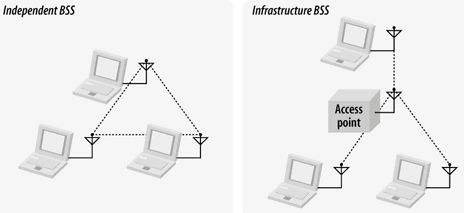Types of Networks
The basic building block of an 802.11 network is the basic service set (BSS), which is simply a group of stations that communicate with each other. Communications take place within a somewhat fuzzy area, called the basic service area, defined by the propagation characteristics of the wireless medium. When a station is in the basic service area, it can communicate with the other members of the BSS. BSSs come in two flavors, both of which are illustrated in Figure below.
All of the wireless media used will propagate in three dimensions. From that perspective, the service area should perhaps be called the service volume. However, the term area is widely used and accepted.

In this tutorial:
- 802.11 Networks
- IEEE 802 Network Technology Family Tree
- Nomenclature and Design
- Types of Networks
- Independent networks
- Infrastructure networks
- Extended service areas
- Multi-BSS environments: "virtual APs"
- Robust security networks (RSNs)
- The Distribution System, Revisited
- Interaccess point communication as part of the distribution system
- Wireless bridges and the distribution system
- Network Boundaries
- 802.11 Network Operations
- Network Services
- Station services
- Distribution system services
- Confidentiality and access control
- Spectrum management services
- Mobility Support
- Designing Networks for Mobility
